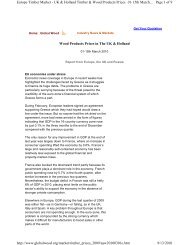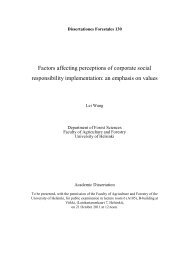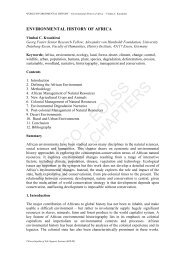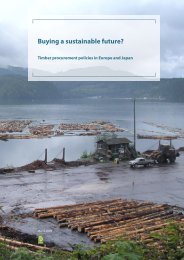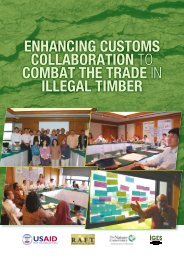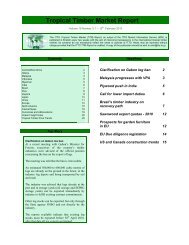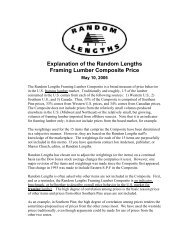ICT and e-Business in the Pulp, Paper and Paper ... - empirica
ICT and e-Business in the Pulp, Paper and Paper ... - empirica
ICT and e-Business in the Pulp, Paper and Paper ... - empirica
Create successful ePaper yourself
Turn your PDF publications into a flip-book with our unique Google optimized e-Paper software.
<strong>Pulp</strong>, paper <strong>and</strong> paper products<br />
track<strong>in</strong>g along <strong>the</strong> supply cha<strong>in</strong> towards <strong>the</strong>ir own customers (e.g. <strong>in</strong> <strong>the</strong> food <strong>in</strong>dustry,<br />
which delivers to retailers).<br />
Packag<strong>in</strong>g <strong>in</strong>dustry: customer dem<strong>and</strong> as a key driver<br />
In <strong>the</strong> packag<strong>in</strong>g <strong>in</strong>dustry (NACE 21.2), RFID adoption is ma<strong>in</strong>ly driven by customer<br />
requirements, <strong>in</strong> particular from companies <strong>in</strong> <strong>the</strong> consumer goods <strong>in</strong>dustry <strong>and</strong> large<br />
retail cha<strong>in</strong>s. They are <strong>in</strong>creas<strong>in</strong>gly consider<strong>in</strong>g <strong>the</strong> use of RFID to improve <strong>the</strong>ir supply<br />
cha<strong>in</strong> processes, which <strong>in</strong>cludes packag<strong>in</strong>g producers. Thus, packag<strong>in</strong>g producers<br />
typically implement RFID to comply with customer dem<strong>and</strong> ra<strong>the</strong>r than proactively as a<br />
means to fur<strong>the</strong>r improve <strong>the</strong>ir own bus<strong>in</strong>ess processes.<br />
Customer pressure is usually exerted by retailers upon consumer goods producers, e.g.<br />
<strong>in</strong> <strong>the</strong> food <strong>and</strong> beverages <strong>in</strong>dustry, 92 which pass on this pressure to <strong>the</strong>ir packag<strong>in</strong>g<br />
suppliers. The large retail cha<strong>in</strong>s have <strong>the</strong> barga<strong>in</strong><strong>in</strong>g power to force members of <strong>the</strong>ir<br />
extended supply cha<strong>in</strong> to adopt <strong>the</strong>ir st<strong>and</strong>ardised RFID related processes.<br />
General <strong>ICT</strong> capability matters<br />
Among manufacturers of P&P (NACE 21.1), several players have taken <strong>the</strong> <strong>in</strong>itiative on<br />
<strong>the</strong>ir own <strong>and</strong> opted to become an early RFID adopter. Examples can be found <strong>in</strong> case<br />
studies presented <strong>in</strong> this report (International <strong>Paper</strong>, Stora Enso). O<strong>the</strong>rs, while also<br />
be<strong>in</strong>g advanced users of <strong>ICT</strong> <strong>in</strong> <strong>the</strong>ir operations <strong>and</strong> B2B exchanges, feel quite<br />
comfortable with a "st<strong>and</strong>-by" strategy. An example is Mayr-Melnhof Karton AG, an<br />
<strong>in</strong>ternational producer of cardboard <strong>and</strong> packag<strong>in</strong>g solutions, who argue that <strong>the</strong>y are well<br />
prepared to adopt RFID "if <strong>the</strong> market should dem<strong>and</strong> it". 93 For <strong>the</strong> time be<strong>in</strong>g, <strong>the</strong>y th<strong>in</strong>k<br />
that costs are still too high (<strong>in</strong> particular for RFID tags) <strong>and</strong> would negate yield<strong>in</strong>g a<br />
positive result over <strong>the</strong> current use of barcode technology, if all costs <strong>and</strong> benefits are<br />
considered. This raises some important questions:<br />
It is debatable whe<strong>the</strong>r <strong>the</strong> strategy of early adoption is to be recommended, <strong>and</strong><br />
whe<strong>the</strong>r companies that decide to delay RFID implementation until customers<br />
dem<strong>and</strong> it ga<strong>in</strong> advantages. Companies have different op<strong>in</strong>ions about <strong>the</strong> 'right<br />
time', i.e. when <strong>the</strong> technology has reached <strong>the</strong> right status of maturity for <strong>in</strong>vestment.<br />
A critical factor <strong>in</strong> that respect is whe<strong>the</strong>r adoption at any po<strong>in</strong>t of time is possible,<br />
or whe<strong>the</strong>r this move needs to be prepared <strong>and</strong> suitably timed well <strong>in</strong> advance.<br />
There is no clear answer to <strong>the</strong>se questions. Analysts <strong>and</strong> <strong>in</strong>dustry experts take different<br />
positions, hav<strong>in</strong>g good arguments for ei<strong>the</strong>r option. In <strong>the</strong>ir White <strong>Paper</strong>, Bear<strong>in</strong>gPo<strong>in</strong>t, a<br />
consultancy, addresses <strong>the</strong> broad issues manufacturers are fac<strong>in</strong>g with regard to RFID<br />
<strong>and</strong> concludes that "a good-sized hill st<strong>and</strong>s before those manufacturers who have been<br />
told by <strong>the</strong>ir customers to implement radio frequency identification (RFID). Companies<br />
large <strong>and</strong> small that sell goods (…) to <strong>the</strong> nation’s largest retailers will be learn<strong>in</strong>g<br />
firsth<strong>and</strong> that light<strong>in</strong>g up crates <strong>and</strong> cases with RFID is more than an <strong>in</strong>cremental<br />
92<br />
93<br />
Cf. e-<strong>Bus<strong>in</strong>ess</strong> W@tch Sector Study on Food <strong>and</strong> Beverages (2006), available at<br />
www.ebus<strong>in</strong>ess-watch.org ('resources').<br />
Interview with Erasmus Pachta, Manager Electronic Solutions & Services, on 27 March 2006<br />
138



